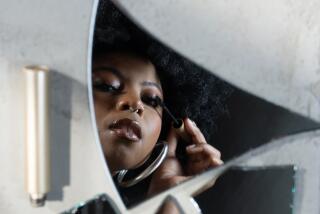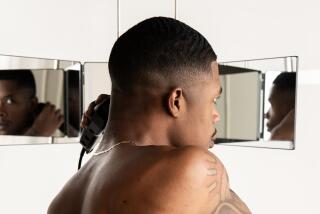The curly-hair conundrum
- Share via
Thanks a lot, Gwyneth Paltrow.
It’s been more than 10 years since the actress and style icon showed up at the “Shakespeare in Love” premiere with long, stick-straight extensions. And suddenly, boom — “Blow-out salons [popped up] across the landscape. It also was when hairstylists started Japanese straightening treatments and then Brazilian,” says Kristin Perrotta, executive editor at Allure magazine. No matter, she adds, that not everyone could pull off the look.
But although we might not have always tried to achieve stick-straight hair, many curly-haired women have been fighting the good fight for generations. My life has been a constant push-pull battle with my hair for 30 to 45 minutes at least four times a week since I was 13. This ritual keeps me from feeling like an awkward, frazzled tween. I plan gym visits around it, have blown out tons of wall sockets, avoid pool parties and dread the Midwest in August. Several roommates and neighbors have been awakened or lulled to sleep by fire-blasting hair dryers that whip and shape and wrestle my normally wavy-frizzy light brown hair into some semblance of sleek order.
And I’m not alone. Google “curly hair” and find message boards, blogs and products set to offer a sort of support system for untamable, frizzy, disorganized bad hair days. There are, of course, similar guides for women with straight hair, but the first page of Google results for “straight hair” are almost all on how to achieve it.
“I find that curly-haired people are obsessed about what they put on their hair,” says Rodney Cutler, owner of Cutler/Redken salons in New York and Miami, saying that curly-haired people are “more inclined to give their two cents in their experience in the haircut.”
“Straight-haired woman will look on the front of the [hair product’s] bottle and it’s a catchy, emotional sell,” Cutler adds. “Curly-haired people go to the back of the bottle” — for the ingredient list. “They know their hair and they know what works. There’s the curly-haired crowd who just want to embrace the hair they have and then there’s the crowd who are not sure what do with it, so they want to reinvent it.”
Why are we like this?
“The curse for curly hair is unreliability,” Tracy Brisson, 35, wrote on a colleague’s Facebook page when I asked if I was alone with these thoughts. “I just did a head shot for my new business and I agonized for days (to the point of feeling sick about it) over what to do with my frizzy Portuguese hair. I felt like I should straighten it, because that’s ‘corporate’ and more importantly, easy, but it’s not me and I am supposed to be selling me. I feel more comfortable in my curls, but they are so much harder to get right that I felt like I was taking a huge gamble.”
Brisson, of New York City, did end up wearing her hair curly in the pictures for her new job as a career coach but, during a later phone interview said she’s considered using a professional relaxer. “I feel straight hair has a lot more professional connotations on it,” she says.
And to some degree, she’s right.
“No hair color, texture, style has any inherent meaning or any inherent interpretation,” says Rose Weitz, a professor of women’s and gender studies at Arizona State University and the author of “Rapunzel’s Daughters: What Women’s Hair Tells Us About Women’s Lives.” “At the same time, there are certain trends. One is that curly is more associated with childhood innocence ... Mary Pickford had waist-length curled blond hair until she was in her 40s. The other association is the reverse ... there’s an image of curly hair as wild and sexy and erotic. In this culture, in this time and place, it is certainly a safer place to have straighter hair in the work force, especially if you are Jewish or Greek or Italian or Latina — ‘not quite like us.’”
In 2008, “Good Morning America’s” Taryn Winter Brill conducted a straight-versus-curly experiment and showed pictures of herself with each hairstyle to various focus groups. The men — who, we should note, were Caucasian — liked the straight-hair look better. So did a roomful of schoolchildren. However, employers conducting mock interviews gave her curly-haired version higher marks. Brill, who usually wears her hair curly, wore her hair straight when she appeared on the show to discuss her findings.
Teri Evans, a blogger for the website NaturallyCurly.com, conducted a similar not-so-scientific dating test in 2007 by creating two online dating profiles, one with a photo of herself with naturally curly hair and one with her hair straightened. Then she’d wear the opposite look on the date. The photo with the flat-iron style got more page views, e-mails and winks. But — and this is key — the hair didn’t really end up making that much of a difference when she met the matches face-to-face, and the actual dates eventually went OK, as soon as she got comfortable in her curls.
Weitz — who, for the record, wears her hair in a pixie cut with some gel to “give the idea that I have some control over my hair” — says the rejection of curly hair can be especially true in Asian countries (If you’re “in Japan and you have curly hair, it’s like ew, yuck”) and among blacks in the United States.
“We continue to live in a racist society in which white people are put off by and generally unhappy dealing with African-descended people who look African,” Weitz says. “White people in society are more likely to marry, date or give good grades to Africans who look more white. Over the centuries, African Americans learned if they could straighten their hair, they could be seen as more intelligent. Straighter hair came to be seen as more attractive to whites.”
Comedian Chris Rock covered this topic in his 2009 documentary “Good Hair” and was met with a mixed bag of outrage and interest. Alynda Wheat, who is black, argued in a 2009 Entertainment Weekly piece that black women, just like so many women of other ethnicities, don’t necessarily want to be “white” as much as they just want easy-to-manage hair.
Which explains the popularity of expensive yet time-saving hair treatments such as extensions or relaxers, says salon owner Cutler. He says that when his salon started offering new straightening treatments, he never thought women would drop $450 just to save 15 minutes in the morning — but there they were in his chairs.
Fight back, you say? Ignore what society wants? Many of us do. And to some extent, society is conforming to us. Allure’s Perrotta points to new, improved technologies in hot rollers (yes, really; they’re back) and “shiny, thick-looking” 1980s-style hair with curls at the end at the Gucci and Versace runway shows for this fall and winter, and Michael Kors’ “rough-looking textured ponytail.”
But sometimes it seems it’s ingrained in us to choose control over au naturel. Megan McGuiness Kerr, 37, of Long Beach, stopped trying to straighten her tight brown curls years ago. But that doesn’t mean she won’t still purchase new products that claim they will alleviate her problems or that she didn’t take notice that her hair looks “the same at the beginning and end of the days” when she visits her brother in the Arizona mountains, because of the low humidity. As a volunteer worker, she knows that a career outside a boardroom affords her the opportunity to let her curls run free, but she says she still “puts more of an emphasis on flyaways” when she’s “going to board meetings or representing nonprofits.”
Because as Allure’s Perrotta and salon owner Cutler point out — what everyone is really afraid of is frizz.






